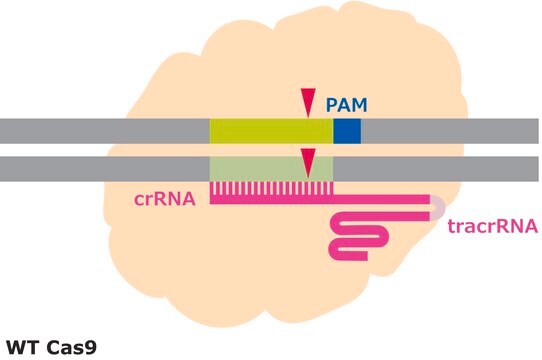HGECKO2G
Gecko2 Human Whole Genome CRISPR Pool, gRNA Only Lenti Particles (Gecko2 vector)
About This Item
Productos recomendados
envase
pkg of 8x25 μL (vials)
Nivel de calidad
concentración
5x108 VP/ml (via p24 assay)
aplicaciones
CRISPR
Condiciones de envío
dry ice
temp. de almacenamiento
−70°C
Categorías relacionadas
Descripción general
Aplicación
Características y beneficios
- Use CRISPR nucleases to knockout protein-coding genes to assess their function
- Efficiently screen the whole human genome (16,000+ genes) at the bench-top without robotics or specialized equipment
- Numerous built-in enrichment and depletion controls allow researchers to confidently gauge the success of their pooled screening experiments
- Lentiviral CRISPRs can infect a broad variety of mammalian cells by transducing a single guide RNA (sgRNA) to a Cas9-expressing human cell line to facilitate gene knockout for screening applications.
- Use the dual vector system for the human GeCKO version 2 libraries for human cell lines that have Cas9 already integrated into the genome.
- Use puromycin gRNA selection after transduction.
Nota de preparación
Otras notas
Información legal
Código de clase de almacenamiento
12 - Non Combustible Liquids
Clase de riesgo para el agua (WGK)
WGK 3
Punto de inflamabilidad (°F)
Not applicable
Punto de inflamabilidad (°C)
Not applicable
Elija entre una de las versiones más recientes:
Certificados de análisis (COA)
It looks like we've run into a problem, but you can still download Certificates of Analysis from our Documentos section.
Si necesita más asistencia, póngase en contacto con Atención al cliente
¿Ya tiene este producto?
Encuentre la documentación para los productos que ha comprado recientemente en la Biblioteca de documentos.
Los clientes también vieron
Artículos
Our lentiviral vector systems are developed with enhanced safety features. Numerous precautions are in place in the design of our lentiviruses to prevent replication. Good handling practices are a must.
Get tips for handling lentiviruses, optimizing experiment setup, titering lentivirus particles, and selecting helpful products for transduction.
Protocolos
You are not alone designing successful CRISPR, RNAi, and ORF experiments. Sigma-Aldrich was the first company to commercially offer lentivirus versions of targeted genome modification technologies and has the expertise and commitment to support new generations of scientists.
FACS (Fluorescence-Activated Cell Sorting) provides a method for sorting a mixed population of cells into two or more groups, one cell at a time, based on the specific light scattering and fluorescence of each cell. This method provides fast, objective, and quantitative recording of fluorescent signals from individual cells.
Nuestro equipo de científicos tiene experiencia en todas las áreas de investigación: Ciencias de la vida, Ciencia de los materiales, Síntesis química, Cromatografía, Analítica y muchas otras.
Póngase en contacto con el Servicio técnico









